What is Job Analysis?
Job Analysis is defined as the process of determining all the necessary information about a particular job i.e., records information about the task involved in the job, the knowledge and skillset required to perform that job, the responsibilities and abilities required for the successful performance of that job.
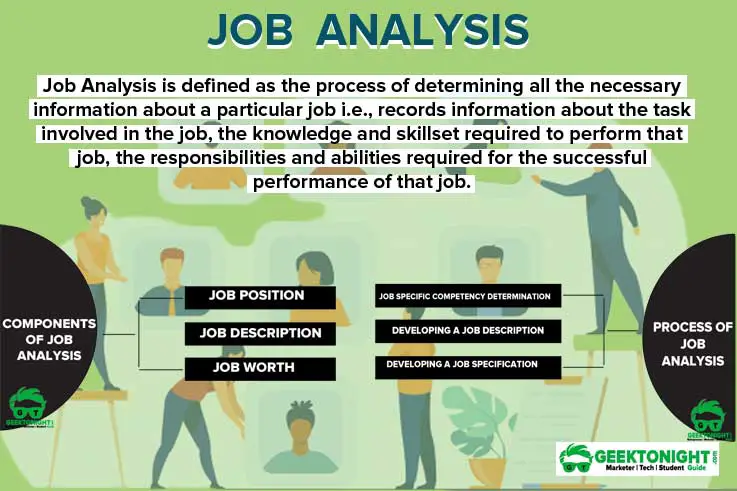
Table of Content
Concept of Job Analysis
Job Analysis is considered one of the most important activities performed by a human resource manager. This article will throw light on the concept of job analysis by describing its meaning, definition, and process with special emphasis on the job description and job specification which are then considered as the end result of job analysis.
The success of almost all the major functions of a human resource manager like training and development, performance appraisal, etc. depends on effective job analysis.
Components of Job Analysis
Following are the components of Job Analysis:
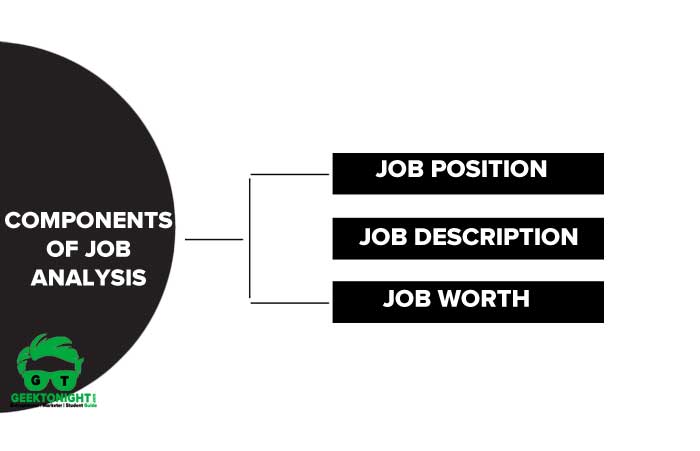
Job Position
The designation of the job and the employee holding that designation in the organization is referred to as the job position. job position serves as the base for the compensation system in an organization.
The high designated job as well as the job holder receives higher compensation in comparison to the lower one. For example the top-level manager of any organization receives more compensation than a lower-level worker.
Job Description
Each job position is different from one another because they require different sets of tasks and responsibilities to hold that position such as experience, expertise and knowledge level. These tasks, duties, roles, and responsibilities describe the in-depth details to perform that job.
Job Worth
Job worth refers to calculating the worthiness of a job in the organization. In other words job, worth estimates how much the job contributes towards the attainment of the organizational overall objective.
It is also known as job evaluation which serves as the base for establishing a fair compensation system in the organization.
Process of Job Analysis
The process of analyzing a particular job may consist of the following steps:
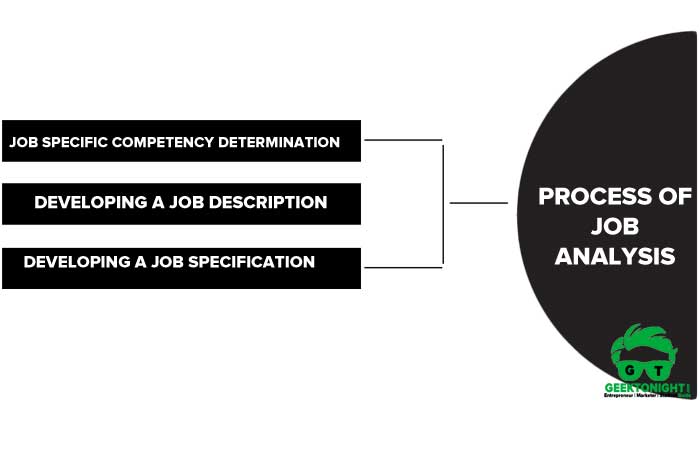
Job Specific Competency Determination
This is one of the key steps for doing a proper jab analysis. Job-specific competency determination means identifying and collecting the job data and using the same data for the preparation of job descriptions and job specifications.
There are various sources through which job data can be collected, for example, job analysts, employee, and supervisors, etc. The data can be collected by using various methods like interviews and observation.
Developing a Job Description
A description of the tasks, duties, responsibilities and functions associated with the job is prepared.
For example, the job description for a marketing manager is to manage and coordinate all marketing, advertising and promotional staff and activities.
Developing a Job Specification
The job specification caters to a complete picture of the competencies and abilities required to perform functions and duties associated with a particular job.
For example, in order to perform the role of a marketing manager, the person holding the position should have a degree in marketing management as well as experience in all aspects of developing and managing marketing strategies.
Methods of Job Analysis
There are different methods of analyzing a job. A manager can use any of the following methods based on situation and suitability to the business organization.
- Observation Method
- Individual Interview Method
- Group Interview Method
- Technical Conference Method
- Diary Method
- Functional Job Analysis
- Position Analysis Questionnaire (PAQ)
- Critical Incident Technique
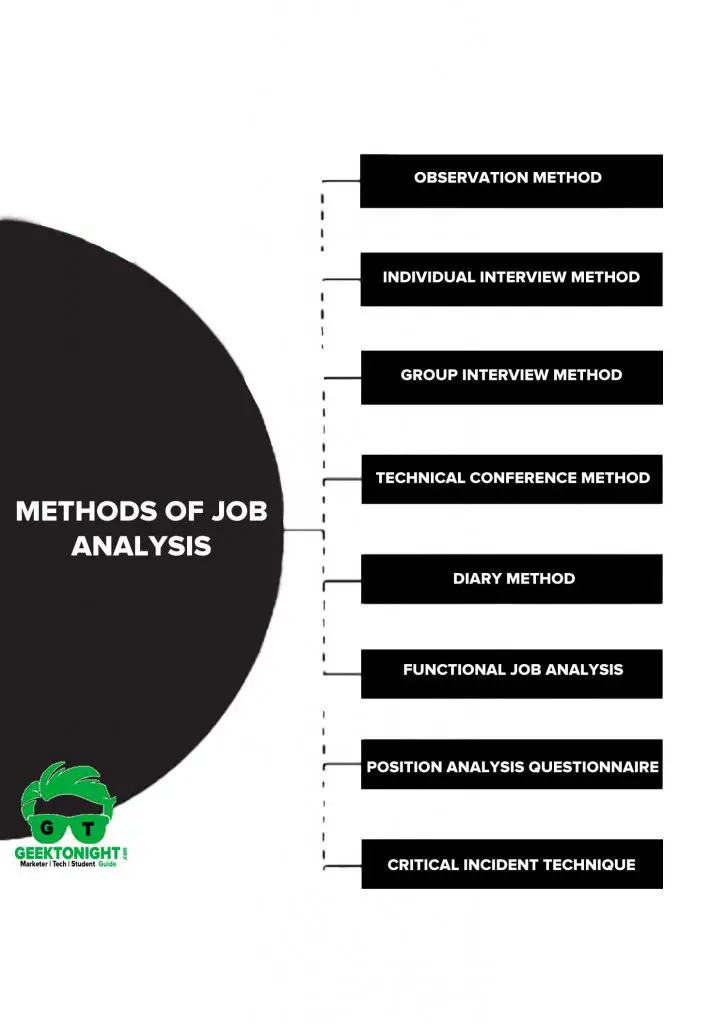
Methods of Job Analysis are:
Observation Method
Observation method is one of the simplest methods for analyzing a job. In this method, the persons holding the job are observed and relevant points are recorded by the observer. The points which are focused while observation is what was done in the job and how it was done.
This method is good for job of repetitive nature. For the job which are non-repetitive in nature, this method is not suitable because it makes the process very difficult and time-consuming as the observer may not be sure what has to be recorded and what has to be ignored.
There are two methods of observation:
- Direct Observation
- Work method analysis
Individual Interview Method
This method is suitable for a job which is complex and involves a variety of tasks. The interview is done between the job analyst and the job incumbent.
The interview could be both structured and unstructured but the structured one is less time consuming and gives the exact data that the analyst is searching for. Most of the time the job data provided by the job incumbent is supplemented by his supervisor also to increase the accuracy of the job data.
Group Interview Method
This method is the same as the individual method. In this method, in spite of interviewing individuals, a group of employees holding a particular job position are interviewed and the data is recorded by the job analyst.
This method is less time-consuming in comparison to individual interview methods but sometimes the effect of group dynamics may change the direction of the interview and the job analyst may not get accurate job data.
Technical Conference Method
In this method, the job-related data is collected from job experts or supervisors. This is considered as a relevant method for collecting unbiased job-related information but the non-involvement of the job holder sometimes doesn’t give the true picture of the job.
Diary Method
In this method of job analysis, the job incumbent requires to record all the activities that he/she performs while being on the job. A lot of information can be gathered with the help of this method but this exercise consumer more time to complete.
There are some activities in the job that are performed once in a month or at definite time intervals, for example sending monthly attendance and doing annual performance appraisal.
Functional Job Analysis
This method of job analysis was developed by US department of labor. In this method, the job analyst conducts interviews with the job incumbents, supervisors, observes sites and then prepares document by doing proper research.
The work functions of a job are categorized as data, people, and things. This technique serves as a basic foundation for grouping jobs into job families.
Position Analysis Questionnaire (PAQ)
The PAQ is a standardised sample questionnaire developed by Ernest J. McCornick’s Position Analysis Questionnaire for job analysis.
The questionnaire contains 194 elements related to job which may divided into six major categories:
- Activities that involve a wide range of information processing exercises that may be accompanied by the use of machines such as office equipment.
- Activities involving decision making, communication and social responsibilities.
- Skilled activities that are performed with the help of technical devices or tools
- Activities that involve considerable movement of the entire body or major parts of it.
- Activities that involve use of vehicles or equipment that typically use sensory and perceptual processes and physical functions.
The PAQ allows management to scientifically and quantitatively analyze group interrelated job element into job dimensions. It represents a high degree of reliability in case the employees do not cooperate in the process or they try to manipulate the information provided.
The information collected from PAQ is helpful in job description and job specification as well as Job evaluation.
Critical Incident Technique
John Flanagan proposed the Critical Incident Technique of job analysis in 1954. According to this technique, behaviour in a particular or specific situation is responsible for the success or failure of individuals or organizations.
A compilation of all the critical actions and behaviour, which involves the action of workers as well as the context in which that act was done, provides a clear picture of the job. The information on critical incidents can be collected and complied with the help of interviews and questionnaire.
What is Job Description?
Job description is the most common end product of job analysis. A job description is a written statement of what the job incumbent does, how it is done, under what conditions it is done and why it is done.
In other words, job description describes in detail the various aspect, scope and purpose of a job. It is a statement of duties, functions, tasks, activities and responsibilities of a position or job.
It represents the working conditions under which a particular job has to be performed as well as the reporting relationship in the organization. Job descriptions are used in crucial Human resource functions like recruitment and selection, training and development and performance appraisal, etc.
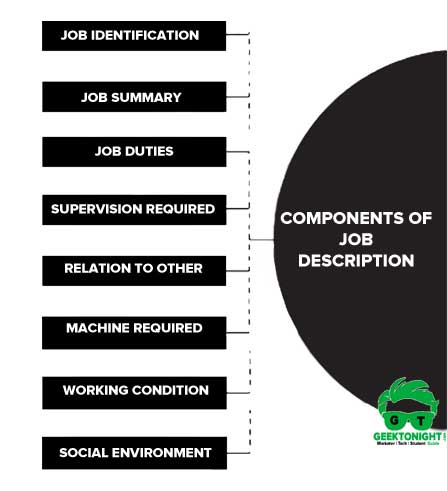
Components of Job Description are:
- Job Identification
- Job Summary
- Job Duties
- Supervision Required
- Relation to Other Jobs
- Machine or Equipment Required
- Working Condition
- Social Environment
What is Job Specification?
The human characteristics required to perform the job satisfactorily are termed as job specifications. It indicates the eligibility criteria which means the qualification, abilities, skills and intelligence, education and expertise required to perform the job.
Elements of Job Specification:
- Educational Requirement
- Experience
- Specific Knowledge Requirement
- Skill Requirement
- Personality Requirement
- Essential Attributes
- Desirable Attributes
- Contra-Indicators
Uses of Job Analysis
Effective job analysis and well-prepared job description and job specification help the HR manager in the successful performance of many HR functions and activities.
These are some uses of Job Analysis:
- Employment
- Organizational Audit
- Training and Development
- Performance Appraisal
- Job Evaluation
- Promotion and Transfer
- Guidance
- Labour Relation
- Health and Safety
- Career Planning
- Succession Planning
- Compensation Management
Employment
There are many functions of the human resource department that helps in employment like manpower planning, recruitment selection placement, orientation and induction. These function takes input from the end result of job analysis.
Organizational Audit
There are many loopholes that may occur in an organization and job analysis identifies those loopholes in terms of jobs, processes and workflow etc. Therefore with the help of job analysis, proper audit of the overall organization can be done and areas of improvement can be identified.
Training and Development
The functions, duties, responsibilities and qualifications that are identified through job analysis for a particular job lays the base for training and development. Until and unless it is clear that which skill is required for the job it would not be possible for the manager to prepare any training and development programme.
Performance Appraisal
Job analysis helps in evaluating the performance of the employee. Evaluation is done against a set standard in terms of task and responsibilities and job analysis helps in framing that standard performance. Therefore it gives an idea about how far an employee is successful in achieving the set standards.
Job Evaluation
Job analysis is helpful in measuring the worth of each job in terms of money in order fix wage and salaries. The jobs in which the functions and duties involve more risk are paid accordingly and their rank is accordingly.
Promotion and Transfer
Promotions and transfer are done on the basis of the requirement of particular function tasks and duties at a specific place or position. Job analysis helps in identifying those responsibilities and duties for a particular job.
Guidance
Job analysis helps the candidates to find a proper job as per their qualification and interest area.
Labour Relation
Labour and associated unions are very much interested in the job description because it defines the tasks and duties involved in the job. The compensation system is basically dependent upon job description, so any change in the job description is of utmost importance for the union.
Therefore, a well-defined job description leads no confusion among the labour and union and maintain cordial industrial relation.
Health and Safety
Job analysis provides knowledge about the harmful working conditions and the hazards associated with the job. Accordingly, safety measures can be taken by the management as well as employee to overcome such hazards.
Career Planning
Job analysis is important for planning the career of individual employees and motivating them to progress in their career.
Job specification gives the employee, the knowledge about the qualification and skills that they require to move ahead in their career.
Succession Planning
A succession plan is referred as the process of grooming a candidate for taking a higher role in future. Job description and job specification help the management to groom the current employee for a future role.
Compensation Management
The compensation management is based on job evaluation, which on the other hand is based tasks, duties and responsibilities involved in a job along with other techniques like market surveys etc.
Human Resources Tutorial
(Click on Topic to Read)
Human Resource Planning
Management Topics
- What is Management?
- Who Is a Manager?
- Marketing CIs Management an Art or Science
- Classical Management Approach
- Planning in Management
- Decision Making in Management
- Organising in Management
- What is Organisation Structure?
- What is Departmentation?
- What is Span of Control?
- What is Authority?
- What is Staffing?
- What is Human Resource Planning?
- What is Job Analysis?
- What is Recruitment?
- Modern and Others Schools of Management Thought
- What is Selection?
- What is Coordination?
- What is Controlling?
- What is Leadership?
- What is Organisational Change?
- Motivation in Management
- Motivation Theories
- Maslow’s Hierarchy of Needs
- Herzberg Two Factor Theory
- Mcclelland’s Needs Theory of Motivation
Go On, Share & Help your Friend
Did we miss something in Human Resource or You want something More? Come on! Tell us what you think about our post on Job Analysis in the comments section and Share this post with your friends.
Human Resources Tutorial
(Click on Topic to Read)



